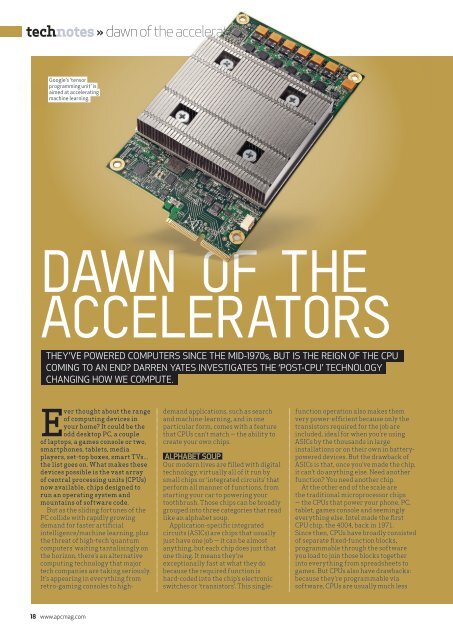You also want an ePaper? Increase the reach of your titles
YUMPU automatically turns print PDFs into web optimized ePapers that Google loves.
technotes » dawn of the accelerators<br />
Google’s ‘tensor<br />
programming unit’ is<br />
aimed at accelerating<br />
machine learning.<br />
DAWN OF THE<br />
ACCELERATORS<br />
THEY’VE POWERED COMPUTERS SINCE THE MID-1970s, BUT IS THE REIGN OF THE CPU<br />
COMING TO AN END? DARREN YATES INVESTIGATES THE ‘POST-CPU’ TECHNOLOGY<br />
CHANGING HOW WE COMPUTE.<br />
Ever thought about the range<br />
of computing devices in<br />
your home? It could be the<br />
odd desktop PC, a couple<br />
of laptops, a games console or two,<br />
smartphones, tablets, media<br />
players, set-top boxes, smart TVs...<br />
the list goes on. What makes these<br />
devices possible is the vast array<br />
of central processing units (CPUs)<br />
now available, chips designed to<br />
run an operating system and<br />
mountains of software code.<br />
But as the sliding fortunes of the<br />
PC collide with rapidly growing<br />
demand for faster artificial<br />
intelligence/machine learning, plus<br />
the threat of high-tech ‘quantum<br />
computers’ waiting tantalisingly on<br />
the horizon, there’s an alternative<br />
computing technology that major<br />
tech companies are taking seriously.<br />
It’s appearing in everything from<br />
retro-gaming consoles to highdemand<br />
applications, such as search<br />
and machine-learning, and in one<br />
particular form, comes with a feature<br />
that CPUs can’t match — the ability to<br />
create your own chips.<br />
ALPHABET SOUP<br />
Our modern lives are filled with digital<br />
technology, virtually all of it run by<br />
small chips or ‘integrated circuits’ that<br />
perform all manner of functions, from<br />
starting your car to powering your<br />
toothbrush. Those chips can be broadly<br />
grouped into three categories that read<br />
like an alphabet soup.<br />
Application-specific integrated<br />
circuits (ASICs) are chips that usually<br />
just have one job — it can be almost<br />
anything, but each chip does just that<br />
one thing. It means they’re<br />
exceptionally fast at what they do<br />
because the required function is<br />
hard-coded into the chip’s electronic<br />
switches or ‘transistors’. This singlefunction<br />
operation also makes them<br />
very power-efficient because only the<br />
transistors required for the job are<br />
included, ideal for when you’re using<br />
ASICs by the thousands in large<br />
installations or on their own in batterypowered<br />
devices. But the drawback of<br />
ASICs is that, once you’ve made the chip,<br />
it can’t do anything else. Need another<br />
function? You need another chip.<br />
At the other end of the scale are<br />
the traditional microprocessor chips<br />
— the CPUs that power your phone, PC,<br />
tablet, games console and seemingly<br />
everything else. Intel made the first<br />
CPU chip, the 4004, back in 1971.<br />
Since then, CPUs have broadly consisted<br />
of separate fixed-function blocks,<br />
programmable through the software<br />
you load to join those blocks together<br />
into everything from spreadsheets to<br />
games. But CPUs also have drawbacks:<br />
because they’re programmable via<br />
software, CPUs are usually much less<br />
18 www.apcmag.com


















